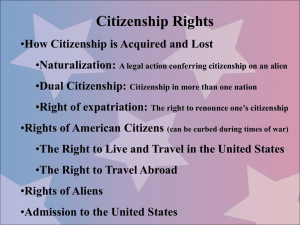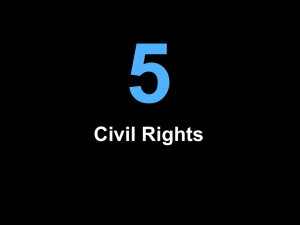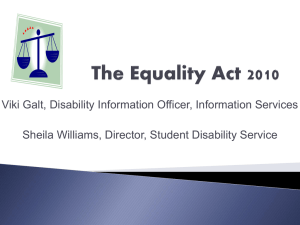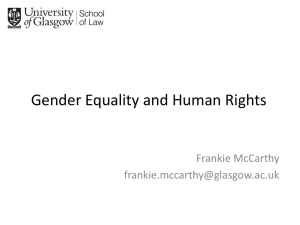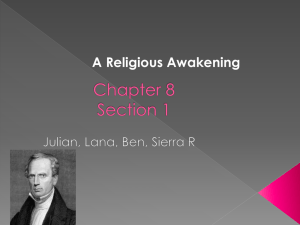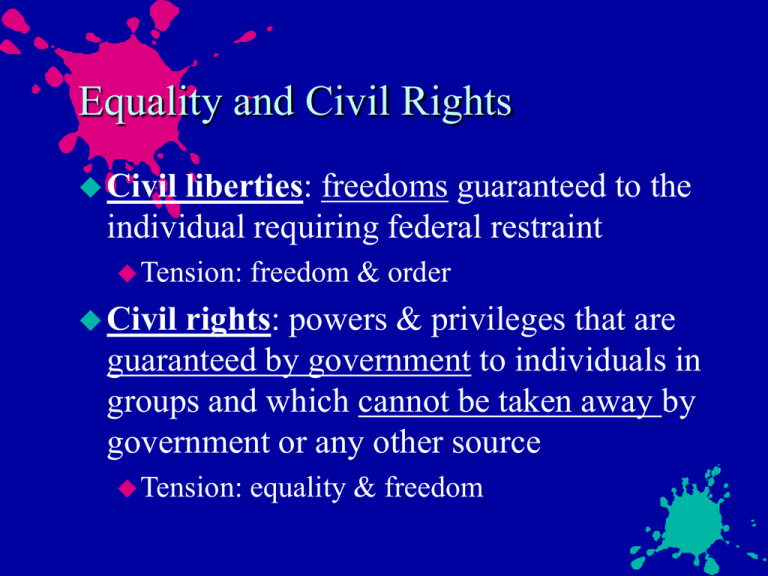
Equality and Civil Rights
Civil
liberties: freedoms guaranteed to the
individual requiring federal restraint
Tension:
freedom & order
Civil
rights: powers & privileges that are
guaranteed by government to individuals in
groups and which cannot be taken away by
government or any other source
Tension:
equality & freedom
Equality and Civil Rights
Origins
of concern lay in pattern of discrimination
against African Americans, even after 13th-15th
Amendments
We discriminate all of the time, but we hope the
discrimination is based on appropriate criteria rather
than on race, sex, ethnic origin, etc.
Overview of Race Discrimination
Declaration
of Independence: We hold these truths
to be self-evident, that all men are created equal…
Constitution contained 3 references to slavery:
Article
I, Sect. 2: Representatives and direct taxes shall
be…determined by adding…3/5ths of all other persons
Article I, Sect. 9: The migration and importation of
persons….shall not be prohibited prior to the year 1808,
but a tax or duty may be imposed…
Article III, Sect. 2: No person held to service or labor in
one state…be discharged from such service or labor
Overview of Race Discrimination
1861-1865:Civil War
fought in part over slavery
1865: 13th Amendment prohibited slavery
1868: 14th Amendment extends citizenship to all
persons born or naturalized in U.S.; no state shall
deprive any person of life, liberty or property
without due process of law...nor deny to any
person ... equal protection of the laws
1870:15th Amendment extends voting rights to
all citizens and prohibits denial on basis of race,
color, or prior condition of servitude
Overview of Race Discrimination
13th-15th Amendments
authorized Congress to
enforce amendments with legislation
1875: Congress passed the Civil Rights Act
prohibiting discrimination in public places (inns,
trains, etc.)
1876 Supreme Court ruled that freedom of
assembly was not protected by 14th Amend. and
that 15th Amend. did not guarantee vote (only
stipulated reasons that could not be used to deny
the vote)
Overview of Race Discrimination
1876:
Presidential election between Republican
Rutherford B. Hayes and Democrat Samuel J.
Tilden was contested; Southern Democrats
conceded in exchange for removal of federal
troops from southern states
Hayes kept promise and removed troops; social
patterns of segregation restored
1877 Georgia introduced the poll tax
Overview of Race Discrimination
1883: Supreme Court found Civil Rights Act
unconstitutional; Congress could only correct state
laws that discriminated against blacks
Private
1896:
associations are off limits (set own rules)
Plessy v. Ferguson: Supreme Court upheld
state laws imposing racial segregation in public
facilities and established the doctrine of separate
but equal
1899: separate but equal doctrine applied to public
schools
Overview of Race Discrimination
1909: W.E. B. DuBois & others founded NAACP
1938: Supreme Court ruled that Lloyd Gaines had
to be admitted to Missouri’s (all white) law school
as a comparable school for blacks did not exist
1947: President Truman ordered desegregation of
the armed services
1954: Brown v. Bd. of Education Supreme Court
ruled that separate but equal had no place in
education; attacked principle at core of equal
protection clause
Overview of Race Discrimination
1955: Rosa Parks refuses to give up bus seat in
Montgomery, Alabama and city boycott organized
1957: Martin Luther King, Jr. organizes So.
Christian Leadership Conference & advocates
civil disobedience
1963: King delivers “I have a dream” speech in
Washington, D.C.
http://www.stanford.edu/group/King
Overview of Race Discrimination
1964
Congress passed Civil Rights Act
Private
lodgings, restaurants, sports arenas, etc.
cannot discriminate on the basis of race
Employers of 15 or more people cannot
discriminate on the basis of race (applied to
state and local governments in 1972)
Overview of Race Discrimination
1964:
Civil Rights Act challenged; Supreme Court
rules in Katzenbach v. McClung that commerce
clause enables Congress to regulate interstate
commerce and, thus, to make racial discrimination
illegal in any business participating in commerce
1964: 24th Amendment banned poll taxes
1965: President Johnson issues Executive Order
11246 required affirmative action by government
contractors to redress discrimination
Overview of Race Discrimination
1968:
Fair Housing Act banned discrimination in
housing
1968: Riots broke out in 168 cities protesting King
assassination
Overview of Race Discrimination
1969: Supreme Court orders desegregation of
public schools immediately
1971: Swann v. Charlotte-Mecklenberg Cnty
Schools Supreme Court identifies remedies such
as busing, racial quotas, pairing school districts to
achieve integration & distinguishes between de
jure and de facto segregation
Segregation
De
Jure segregation
Comes
about because of legislation or court
decisions (acts of government)
De
Facto segregation
Comes
about from different social or economic
circumstances
Affirmative Action
Establishes
remedies to overcome past
discrimination
Raises
question whether outcome is related to
opportunity
Raises question whether to focus on historical
de jure segregation only
Opponents
charge Reverse Discrimination
Court has equivocated as public opinion
shifts
Equality and Civil Rights
Equality
of Opportunity: each person has the same
opportunity to succeed in life
Equality of Outcome: government to design policies
to redistribute wealth and status so that economic
and social equality is achieved
Equality of outcome was originally conceived to be
a temporary adjustment to compensate for historical
pattern of discrimination against African Americans
Overview of Race Discrimination
1974: Milliken v. Bradley limits busing to school
districts with history of discrimination
1976: Regents of U. C. Davis v. Bakke Supreme
Court considered reverse discrimination and found
racial quotas unconstitutional but allowed race to
be one of several factors in admission
1979 and 1980: Affirmative Action plans in
employment upheld; later restricted to narrow area
where history of discrimination proven
Overview of Race Discrimination
1995: Adarand Constructors, Inc. v. Pena placed
restriction on affirmative action in highway
contracts
1996: California passed Proposition 209
prohibiting affirmative action in employment and
college admissions throughout the state
Equal Protection of the law
Supreme
Court has established different
standards for evaluating discrimination in
state laws
Rational
basis (lowest level)
Heightened scrutiny (middle level; gender)
Strict scrutiny (suspect classes including race,
ethnic origin, religion)
Hispanics
1848: Treaty of Guadalupe Hidalgo ended
Mexican-American War and guaranteed
citizenship and land rights to Mexican-Americans
Social practices ignored treaty despite
participation of Hispanics in military efforts
Mexican American Legal Defense (MALDEF) &
Cesar Chavez are examples of civil rights efforts
Focus has been on legislative districts and gaining
representation in state legislatures & Congress
Native Americans
Historically,
Native Americans were concentrated in
tribes with which the Federal Government had
treaties; treaties complex but also abrogated
U.S. government accused of genocide--deliberate
elimination of a population
Native Americans were not granted U.S.citizenship
until 1924
Native Americans Rights Fund (1970) has sought
recognition of tribes and fishing, land & other rights-may conflict with water rights in California
Disabled Americans
1990: Americans with Disability Act requires
access to public buildings and make other
accommodations in employment. Act covers
physical and mental disabilities as well as AIDS
Gays and Lesbians
Rights are largely determined by state laws
U.S. Supreme Court has been reluctant to interfere
Bowers
v. Hardwick (1986) Supreme Court upheld
Georgia statute prohibiting sodomy, even in privacy of
one’s own home
Hawaii Supreme Court (1993) found that equal
protection of the laws extended to homosexual
marriages although constitution amended in 1998
Gays and Lesbians
Congress (1996) passed Defense of Marriage Act
in response to Hawaii Supreme Court decision
Article
IV, Sect. 1 of U.S. Constitution stipulates: Full
faith and credit shall be given in each state to the public
acts, records, and judicial proceedings of every other
state.
Congress’s action exempted homosexual marriages…
Romer v. Evans (1996) found Colorado’s law
invalidating local ordinances supporting
homosexuals unconstitutional
Women’s Movement
1908: Supreme Court upholds Oregon law limiting
number of hours women can work
1920: 19th Amendment passed allowing women to
vote
1923: Equal Rights Amendment proposed
1963: Equal Pay Act requires equal pay for equal
work, where equal work is defined as same job
Women’s Movement
1964: Title VII of Civil Rights Act prohibits
discrimination in employment on basis of race,
color, religion, national origin and sex
1972: ERA passes Congress
1982: ERA dies, lacking ratification of 3 states
race: suspect class; requires compelling state
interest
sex: requires only important state interest



